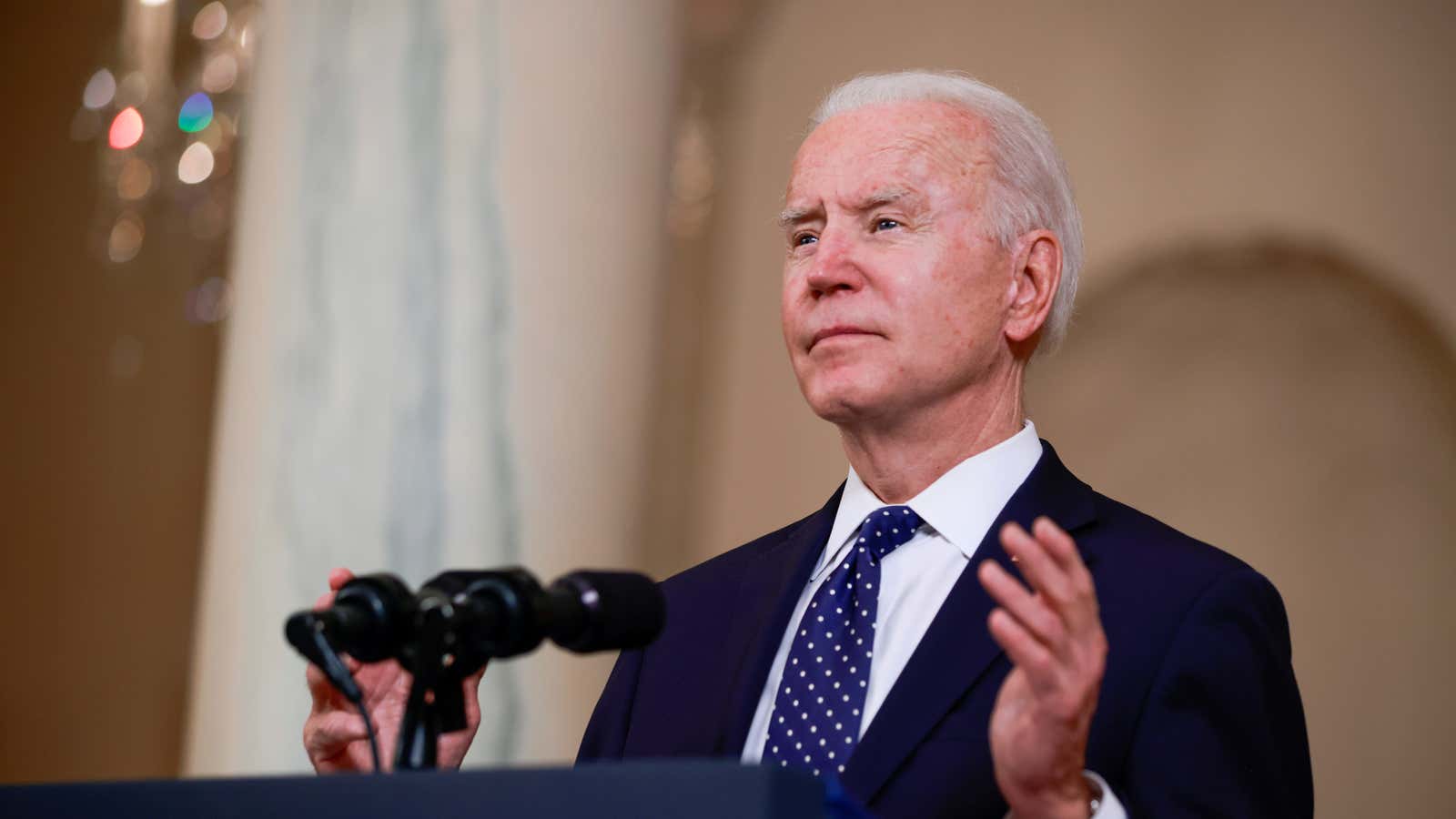US president Joe Biden is raising the minimum wage to $15 an hour—for federal contractors.
Biden had vowed to up the federal minimum wage to that level for all workers, but his efforts to do that have so far failed in Congress. The new rate, which Biden is implementing through an executive order he signed last week, will only cover some 400,000 workers out of 32 million who currently make the minimum wage, according to estimates from the Economic Policy Institute, a left-leaning think tank.
In the long quest to raise American workers’ minimum wage, which has been stuck at $7.25 for 11 years, it pays to have narrow goals. In recent years, getting Congress to hear—never mind pass—bills to increase current levels has been a struggle for workers’ advocates. In March, Republicans and even some members of Biden’s party rejected the latest attempt, which was attached to Biden’s $1.9 trillion Covid-19 relief bill. The minimum wage provision was cut out.
The main argument against a nationwide $15-an-hour minimum wage is that it would make labor too expensive for poorer areas, prompting employers there to shed jobs. A growing amount of research suggests that wouldn’t be the case, however.
As the debate continues, some argue that adjusting the federal minimum wage to local economic conditions would be more appealing to lawmakers than a blanket hike, and thus is the most practical way to get the lowest-paid workers a pay raise, even if not all of them end up earning $15 an hour.
So far, the local approach has been working, with cities and states passing their own $15-an-hour minimum wage initiatives as political gridlock stalls any changes in Congress. But some economists say that’s not enough.
Why the minimum wage needs to be raised
In the US, the concept of a federal minimum wage was introduced by president Franklin D. Roosevelt in 1938 under the Fair Labor Standards Act. It was set at 25 cents an hour and excluded certain industries including agriculture and domestic services. The purpose of the minimum wage was to stabilize the economy after the Great Depression and to create a minimum standard of living for employees across the country.
It was a controversial issue from the start, with economists wrangling over whether it did more harm than good. By the 1980s, most economists agreed that the minimum wage had a negative impact based on research that showed it caused some loss in employment, even as there was disagreement about how much. Then in 1993, economists David Card and the late Alan Krueger published a paper that compared the unemployment rate for fast-food workers in New Jersey, where the state had just raised the minimum wage, with that in nearby eastern Pennsylvania. They found no difference between the two. Since then, numerous empirical studies have largely backed those findings.
Nevertheless, the federal minimum wage has not been increased since 2009. That means that in real terms, its current level is lower than it was 50 years ago: While in 1960, the federal minimum wage was roughly half of the median wage, today, it is roughly one-third.
While the debate over the wisdom of having a minimum wage remains contentious in Washington DC, many economists have moved on to discussions about when it makes sense to raise it and by how much, says Attila Lindner, a University College London professor who has studied the impact of raising wages in US cities. Current economic conditions in the US, he adds, warrant a rate much higher than $7.25 an hour.
The impact of different wage increases
Economists like him have plenty of case studies to test what works best. Cities ranging from Seattle to Denver have committed to reaching that level in the next several years. Twenty-nine states—including Florida, which passed a law to increase its minimum wage to $15-an-hour last November—now have a higher minimum wage than the federal government.
So far, those raises have lowered poverty levels while causing minimal job loss, says Lindner, who looked at 138 state-level wage hikes between 1979 and 2016.
A city-by-city approach addresses concerns that $15-an-hour may be too high—or too low—for some places. For example, Lindner estimates that a $25 minimum wage would be right for San Francisco. Given the city’s median wage levels and the high cost of living “you need a larger minimum wage to lift their living standards.” Meanwhile, New York City would warrant a lower minimum wage than San Francisco’s, since the median wage there is already $22 and the geography covers more of a range of jobs and incomes.
That said, setting levels locally cannot substitute a substantial increase in the federal minimum wage, which would ensure that workers in places that don’t change their policy get a raise too. There are also limits to local tailoring: Oregon and New York, for example, don’t allow localities to adopt their own minimums.
To achieve a national wage floor, some economists argue a $12-an-hour rate would be an easier sell.
Still, some see Biden’s executive order as a useful start. “It’s not going to be as impactful as a minimum wage standard that applies to the labor market,” says Ben Zipperer, an economist at EPI. “But in the absence of that happening, I think it makes a lot of sense to push as many levers as possible to raise wages for those at the bottom of the wage distribution.”
